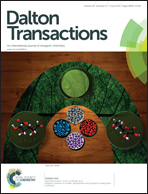pH-Induced processes in wire-like multichromophoric homo- and heterotrimetallic complexes of Fe(ii), Ru(ii), and Os(ii)†
Abstract
In this work we studied the influence of pH on the absorption, steady state and time-resolved emission spectroscopic behaviors of recently reported multichromophoric trimetallic complexes of the forms [(bpy)2M(phen-Hbzim-tpy)M′(tpy-Hbzim-phen)M(bpy)2]6+ (M = RuII or OsII, and M′ = FeII, RuII, and OsII) derived from a heteroditopic phenanthroline-terpyridine bridge, 2-(4-(2,6-di(pyridin-2-yl)pyridine-4-yl)phenyl)-1H-imidazole[4,5-f][1,10]phenanthroline (tpy-Hbzim-phen) and 2,2′-bipyridine (bpy) as the auxiliary ligand. For purposes of comparison, the UV-vis absorption and emission titrations of three monometallic model compounds [(bpy)2Ru(phen-Hbzim-tpy)](ClO4)2 (1), [(bpy)2Os(phen-Hbzim-tpy)] (ClO4)2 (2) and [(tpy-PhCH3)Ru(tpy-Hbzim-phen)](ClO4)2 (3), where tpy-PhCH3 = 4′-(4-methylphenyl)-2,2′:6′,2′′-terpyridine) were studied under the same experimental conditions. The absorption titration data were used to determine the ground state pKa values, whereas the luminescence and lifetime data were utilized for the determination of excited state pKa* values of the complexes. The evolving factor analyses of the set of absorption spectra of the complexes obtained by varying the pH of the solution confirm that only three absorbing species exist in the pH window of 2–12. Moreover, the modulation of the rate of the intramolecular energy transfer among the components in the homo- and heterotrimetallic complexes as a function of pH of the solution was also demonstrated.


 Please wait while we load your content...
Please wait while we load your content...